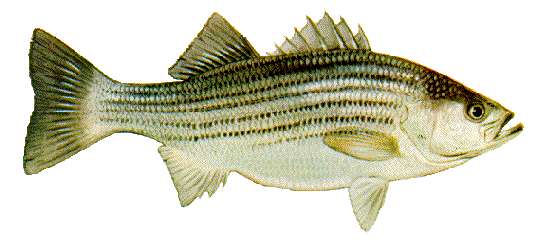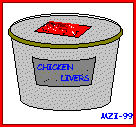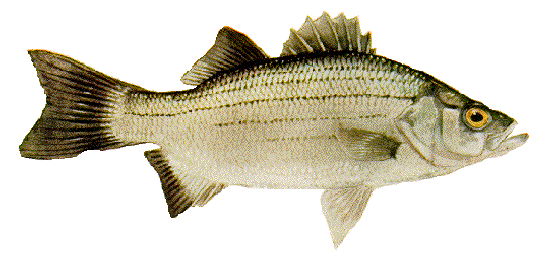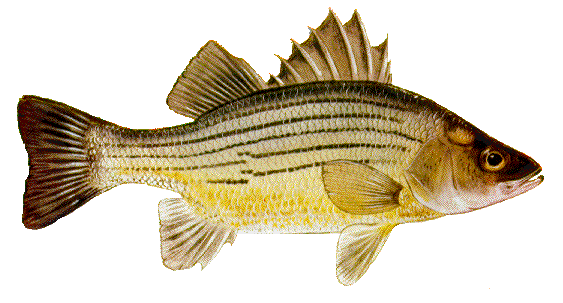 |
 |
STRIPED BASS
 |
 |
| A. Has two, distinct tooth patches near the midline towards the back of the tongue. |
| B. Body slender, less than 1/3 length. |
| C. Stripes distinct, several extend to tail. |
DESCRIPTION:
The striped bass also called "STRIPER", is the
largest member of the sea bass family, often called
“temperate” or “true” bass to distinguish
them from species such as largemouth, smallmouth, and spotted
bass which are actually members of the sunfish family
Centrarchidae. As with other true basses the dorsal fin is
clearly separated into spiny and soft-rayed portions. Striped
bass are silvery, shading to olive green on the back and white on
the belly, with seven or eight continuous horizontal stripes on
each side of the body. Younger fish may resemble white bass.
Striped bass have two sharp points on each gill cover.
Additionally, the second spine on the anal fin is about half the
length of the third spine.
HABITS:
The striped bass is anadromous, native to a variety of habitats
including shores, bays, and estuaries. In coastal populations
individuals may swim up streams or rivers as far as 100 miles
inland to spawn. There are land-locked populations that complete
their entire life cycle in freshwater. These generally, ascend
tributaries of the lakes or reservoirs where they spend their
lives. Spawning begins in the spring when water temperatures
approach 60 °F. Typically, one female is accompanied by several
males during the actual spawning act. Running water is necessary
to keep eggs in motion until hatching. In general, 50 miles or
more of stream is required for successful hatches. Striped bass
“stripers” may reach a size of 10 to 12 inches during
the first year. Males are generally mature in two years, and
females in three to four. Adults are primarily feed on members of
the herring family such as gizzard shad, threadfin shad.
|
|
GIZZARD SHAD |
THREADFIN SHAD |
GIZZARD and THREADFIN Shad can be caught with a standard throw
net, The best method for using Shad as bait is the "Carolina
Rig"![]() to your bait.
use an 18" leader.
to your bait.
use an 18" leader.
Follow this link for a HOW-TO on the use of a Throw Net,
HABITAT:
The striped bass is a coastal species that moves far upstream
during spawning migrations in coastal rivers. The native range is
along the Atlantic coast east of the Appalachian Mountains from
New Brunswick south to Florida and west into Louisiana. The
species has been introduced at scattered locations throughout the
central U.S. There have also been introductions as far west as
the Colorado River in Arizona, and at various sites in
California. Although not native to Texas the species has been
stocked in a number of reservoirs where excellent fisheries are
maintained. Most notable is Lake Texoma along the Red River in
northeastern Texas.
SPECIAL INFO:
Striped bass are the fourth most preferred species among
licensed Texas anglers. It is estimated that the economic impact
of striper fishing in the Lake Texoma area alone totals well in
excess of $20 million. Striped bass are often captured using
various artificial lures that imitate small fish, such as silver
spoons. Deep running lures can also be effective, as may live
bait, or cut bait. In Texas, striped bass in excess of 45 pounds
have been landed. Although specimens exceeding 100 pounds have
been caught in saltwater, to date a 66 pounder was the largest
individual reported from inland waters.
HYBRID STRIPED BASS
|
 |
| A. Has two, distinct tooth patches near the midline towards the back of the tongue. |
| B. Body deep, more than 1/3 length. |
| C. Stripes distinct, usually broken, several extend to tail. |
DESCRIPTION:
Hybrid striped bass also called "Hybrids",
"Wiper", "Sunshine bass", are a silver
deep-bodied fish, similar to white bass. Stripes along sides and
back are distinct, usually broken, with several extending to the
tail. Teeth on the base of the tongue are arranged in two
parallel patches. The hybrid striped bass is created by crossing
a female striped bass with a male white bass. Hybrids often weigh
between 1 and 5 pounds, and range from 12 to 22 inches. They may
grow to 16 pounds.
HABITS:
Hybrid striped bass generally cannot reproduce although
River based hybrids spawn successfully because of running water
not available in lakes. The eggs are semi-buoyant and float in
the water until they hatch. Lake eggs simply sink to the bottom
then die. Hybrids tend to grow faster than their parents. They
prey on gizzard shad. They can often be found by watching for
birds circling and feeding on the water top. This happens when
schools of hybrid striped bass herd gizzard shad to the
water’s surface where the shad are easier to catch. Hybrids
are fast growing fish that are hard fighters when hooked. Hybrids
grow from eight to 10 pounds quickly. This size fish can easily
devour a 14-inch gizzard shad. Shad control also benefits
anglers. Shad compete with crappie and other game fish for food.
Less competition for forage gives desirable fish faster growth
rates.
HABITAT:
They have been stocked into reservoirs and rivers
throughout the Midwest and southeastern United States. Hybrid
stripers often use open water habitat, and are more tolerant of
warmer water than striped bass.
SPECIAL INFO:
Hybrid striped bass will bite live baits, including
shad, nightcrawlers, and soft crawfish. Live baits should be
fished near the bottom. Jigs, jigging spoons, and crankbaits are
good lures for casting. Trolling with large deep-diving
crankbaits can also be productive.  The ancient use of chicken liver for catfish has
surprised many Catfishermen because liver anglers may set the
hook on a fish that will test their tackle beyond belief. Many
chicken liver catches are recorded by catfishermen. Hybrid striped bass love liver. Some claim that
chicken liver slightly smells like gizzard shad. Hybrids may be
caught by two methods: Lures or by fishing chicken liver and shad
fished just off the bottom. This is likely one of the better ways
to catch a hybrid. Throughout spring, fishermen routinely find
hybrids around rock rip rap generally associated with dams or
hard rock points. Both crankbaits or top water lures are
effective. Topwater lures twitched along the shore will draw
strikes. Hybrids feed on almost 100 percent shad, so choose your
lure colors accordingly. Crankbaits from boat, shore and across
the hard rock points are also effective. Crankbaits are extremely
good throughout the summer months. Hybrids school and move around
in search of gizzard shad. They are less apt to suspend like
largemouth bass in summer or winter. Hybrids like to roam.
The ancient use of chicken liver for catfish has
surprised many Catfishermen because liver anglers may set the
hook on a fish that will test their tackle beyond belief. Many
chicken liver catches are recorded by catfishermen. Hybrid striped bass love liver. Some claim that
chicken liver slightly smells like gizzard shad. Hybrids may be
caught by two methods: Lures or by fishing chicken liver and shad
fished just off the bottom. This is likely one of the better ways
to catch a hybrid. Throughout spring, fishermen routinely find
hybrids around rock rip rap generally associated with dams or
hard rock points. Both crankbaits or top water lures are
effective. Topwater lures twitched along the shore will draw
strikes. Hybrids feed on almost 100 percent shad, so choose your
lure colors accordingly. Crankbaits from boat, shore and across
the hard rock points are also effective. Crankbaits are extremely
good throughout the summer months. Hybrids school and move around
in search of gizzard shad. They are less apt to suspend like
largemouth bass in summer or winter. Hybrids like to roam.
Try this exciting species for some tackle-busting excitement. This cross between a male white bass and female striped bass fights to the point of exhaustion.
NOTE: I've been told by many fishermen, that not only Hybrid Striped Bass hit Chickenlivers But ANY Striped Bass will hit this unorthodoxed bait. Try it in the Surf and be surprized at the amount of Stripers you will catch...Let me know if you do!
WHITE BASS
 |
 |
| A. Has one tooth patch near the midline towards the back of the tongue. |
| B. Body deep, more than 1/3 length. |
| C. Stripes Faint, only one extends to tail. |
DESCRIPTION:
Again, as with other true basses the dorsal fin is
clearly double, separated into spiny and soft-rayed portions.
White bass are silvery shading from dark gray or black on the
back to white on the belly. Several incomplete lines or stripes
run horizontally on each side of the body. Adults resemble young
True Striped Bass, and the two are often confused. White Bass
have one tooth patch, white bass have one point on the tip of
their gill plate, the second spine on the anal fin is about
two-thirds the length of the third spine.
HABITS:
White bass are active early spring spawners. Schools of
males migrate upstream to spawning areas as much as a month
before females. There is no nest preparation. Spawning occurs
either near the surface, or in midwater. Running water with a
gravel or rock substrate is preferred. Females rise to the
surface and several males crowd around as the eggs and sperm are
released. Large females sometimes release nearly a million small
eggs during the spawning season. After release eggs sink to the
bottom and become attached to rocks, hatching in 2-3 days. Fry
grow rapidly, feeding on small invertebrates. White bass may grow
eight or nine inches during the first year. Adults are usually
found in schools. Feeding occurs near the surface where fish,
crustaceans, and emerging insects are found in abundance. Gizzard
and threadfin shad are the preferred food items. White bass
greater than four years of age are rare.
HABITAT:
White bass are native to the the central U.S. west of
the Appalachians, including the Great Lakes, as well as river
systems in the Ohio and Mississippi river valleys. In Texas the
species is native to the Red River drainage.
SPECIAL INFO:
White bass are the fifth most preferred species among
licensed Texas anglers. Schools of white bass feeding on shad
generate much excitement among anglers. Once a school has been
located successful anglers often fish the surface with spoons or
spinners. Alternatively, bottom fishing at night with live bait
may also produce great success. White bass are excellent
fighters, and are considered superb table fare.
YELLOW BASS
 |
|
| A. Does not have a tooth patch near the midline towards the back of the tongue. |
| B. Stripes distinct, broken above anal fin. |
| C. Dorsal fins joined. |
| D. Color - silvery yellow. |
DESCRIPTION:
Yellow bass are sometimes confused with white bass or
young striped bass, there are several distinguishing
characteristics. First, the belly may take on a yellow colors
from which the species derives its common name. Second, unlike
other temperate bass, the two lowermost stripes are distinctively
broken just posterior to the middle, and third the second and
third anal spines are approximately equal in length.
HABITS:
Yellow bass, like other members of the sea bass family
are spring spawners. They prefer gravel or rock substrate for
spawning, but unlike other sea basses they do not appear to
require flowing water, and they temporarily pair during spawning.
Eggs are usually deposited in two to three feet of water. At
water temperatures of 70 °F, eggs hatch in four to six days.
Yellow bass are slow growers, reaching four or five inches the
first years, and only growing one to two inches per year
thereafter. They reach sexual maturity in only two years (six to
seven inches). Young fish feed primarily on fish, crustaceans,
and insects. Adults often eat large quantities of fish, and may
even cannibalize their own young. Schools are most often found in
midwater or near the surface.
HABITAT:
Although native populations do exist in areas of Oklahoma,
Texas, and Mississippi, the species was primarily restricted to
the Mississippi River from Minnesota to Louisianna. Introduced
populations ocurr as far west as Arizona, as far north as
Wisconsin and Iowa, and as far east as central Tennessee. In
Texas yellow bass range from the Red River south to the San
Jacinto drainage.
SPECIAL INFO:
Yellow bass are often found in schools. Like white bass they may
be captured using spoons, spinners, or live minnows. However, due
to their small size, averaging only about half a pound, and slow
growth rate they are not highly sought by most anglers (a trophy
fish may not exceed one pound).